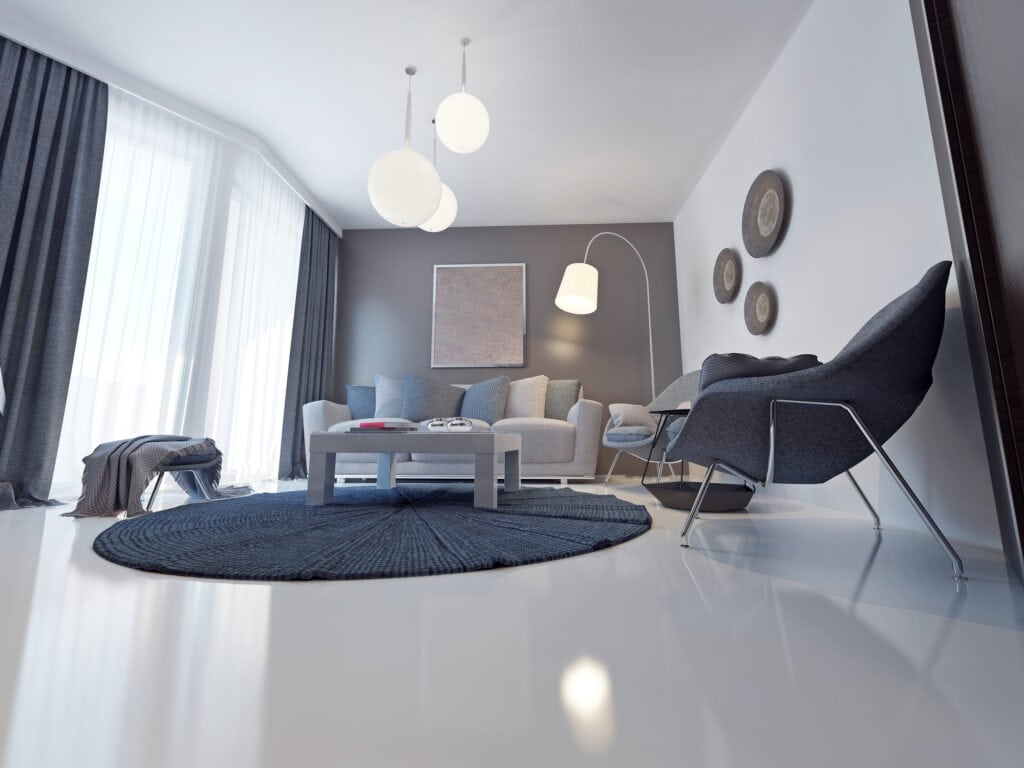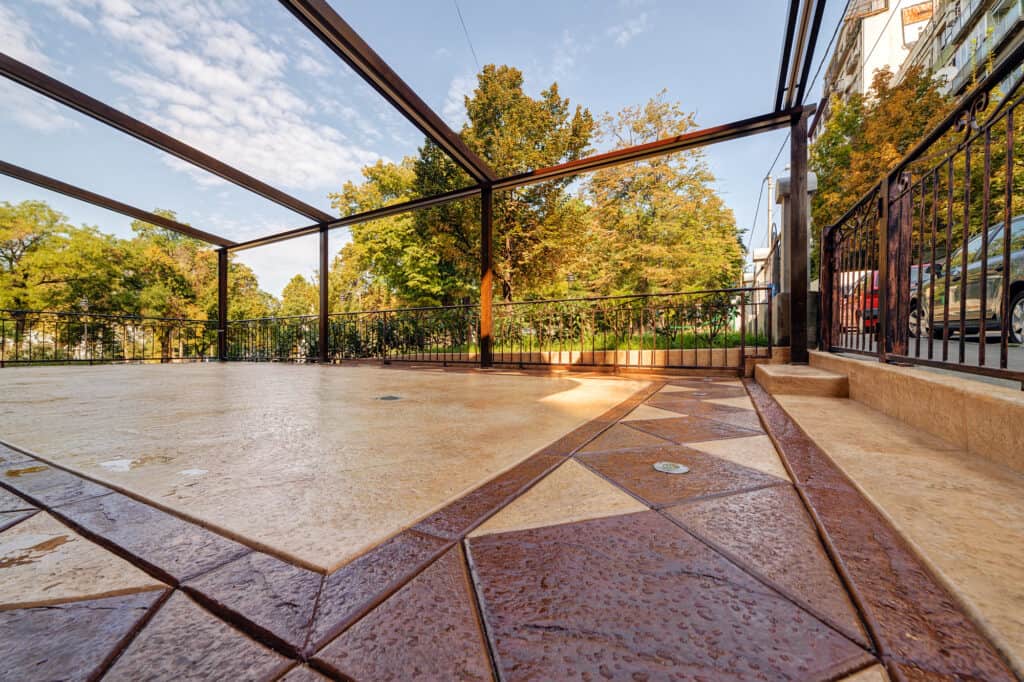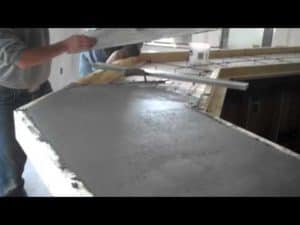
The versatility of concrete has transcended its traditional uses and has paved the way for it to become a sought-after flooring choice in modern homes. Not simply confined to industrial or outdoor applications, concrete now brings a sophisticated edge to interior living spaces. With methods like polishing, etching, and staining, this material offers a multitude of design possibilities. Yet, concrete is not universally suited to all living environments or styles; it thrives in homes designed with specific architectural foundations that allow for its integration.
While concrete flooring is lauded for its durability and longevity, potentially outlasting many other flooring options, it does come with inherent drawbacks. Its robust nature translates into a hard surface underfoot, which can be cold and unwelcoming in cooler climates. Additionally, homes with concrete floors may face challenges like moisture migration and slip hazards. Nevertheless, the economic and maintenance benefits are compelling for homeowners considering this flooring option.
Key Takeaways
- Concrete flooring offers design versatility and long-lasting durability.
- Installation is most practical in homes with specific foundation types.
- Despite its strength, concrete can be cold and is prone to moisture issues.
Concrete Floor Pricing
When installing concrete flooring, the expenses differ significantly depending on the desired finish. Here are the cost ranges for different levels of design complexity:
- Simple polished concrete: Costs for this economical option begin at $2, rising up to $6 per square foot. It typically encompasses the pouring process and adds a straightforward polish with a single-tone stain or dye.
- Intermediate styled concrete: These floors fall into a moderate price bracket starting from $7 to $14 for each square foot. The process usually includes pouring the base, enhancing with detailed polishing, and applying multiple staining shades.
- Advanced artistic concrete: At the higher end, intricate designs can cost anywhere between $15 to $30 a square foot. These premium options might feature elaborate geometric patterns, multi-hued color schemes, and diverse texturing or stamping methods, denoting a more artisanal approach.
Regarding longevity, a sealed concrete floor is known for its durability, often outlasting many alternatives in high-traffic areas for years, making it a cost-effective and long-lasting flooring choice.
Maintenance and Repair
Concrete flooring is known for its robustness and longevity, becoming a ubiquitous choice for industrial settings and, increasingly, for homes. This type of flooring is highly resistant to physical damage. It stands up well against heavy foot traffic, resists scratches from items such as furniture legs, high heels, and pet claws, and is also tough against impact from most dropped objects. To inflict harm on these surfaces, significant force is typically needed.
Maintaining the appearance of a concrete floor requires a minimal amount of effort. The application of a sealant or wax should occur every one to three years, depending on how much footfall the area receives, to preserve the floor’s protective top layer. For regular cleaning, a neutral cleaner can be used to mop the floors. For difficult stains, employing a blue utility pad is advisable.
Over time, concrete floors may show signs of settling or cracking. This is notably common when a space, like a converted basement or loft, has transitioned from its original purpose to residential use. Should the surface exhibit pronounced cracks, there exist methods to repair: patching, grinding down the uneven areas, and refinishing can be done to return the floor’s original luster.
Design Aesthetics and Techniques for Concrete Flooring

Concrete flooring has evolved to become a versatile and stylish option for modern and industrial interiors. It offers an array of finishes that cater to different design preferences.
Customizations for Concrete Floors:
- Overlaying: A new thin concrete layer added on top of an existing floor revitalizes the surface.
- Polishing: Achieving a mirror-like finish involves refining the surface using fine abrasive materials.
- Acid Staining: A mild acid solution creates unique, variegated patterns resembling marble.
- Dye Application: For a uniform color, dyes impart a consistent shade across the surface.
- Texturing: Various techniques, such as stamping or embedding materials, add three-dimensional depth.
- Geometric Patterns: Floors may feature distinct shapes and designs, with each section uniquely treated.
- Artistic Details: Techniques like stenciling or airbrushing turn concrete into a canvas for creative expression.
These decorative options extend the suitability of concrete floors beyond the traditional settings, allowing them to complement numerous architectural styles, from the rustic to the sleek contemporary. However, the timeless appearance of a simple polished concrete floor still holds its place for those seeking a minimalist or no-frills look.
Concrete Floor Installation Process
Installing a concrete floor typically involves several steps, whether you’re working with an existing slab or starting from scratch. Here’s a quick guide to the process:
- Surface Preparation:
- If there’s already a concrete slab in place, remove any existing floor coverings to expose the concrete.
- For slabs in poor condition, apply a new layer of concrete to serve as a fresh surface.
- Adding Color and Texture:
- Mix colorizing agents into new concrete before pouring for a consistent tint throughout the slab.
- For existing concrete, after smoothing, apply stains or dyes to achieve the desired color effect.
- Polishing the Surface:
- Grind the concrete slab using abrasive pads, escalating to finer grits to attain a polished finish.
- Sealing the Floor:
- After polishing and colorizing, seal the surface to protect the concrete.
- Regular maintenance, typically on an annual basis, involves resealing to maintain the floor’s durability and appearance.
- Installation Over Wood:
- Pour a thin concrete overlay over a prepared wood subfloor, which may require structural reinforcement due to the weight.
- Professional vs. DIY:
- The complexity of the work generally necessitates hiring a professional, due to the specialized tools and skills required.
- Those who are highly skilled in DIY home projects may opt to rent the necessary equipment for the task, although caution is advised.
Remember, a well-installed and smooth concrete floor allows for future flexibility in home design, as it can later be covered with different flooring materials if desired. Proper installation ensures that the floor remains even, without holes or bumps that could interfere with further refurbishments.
Downsides
Concrete flooring, while celebrated for its sturdiness and longevity, possesses certain characteristics that may detract from its appeal for specific applications. Here are some of the notable disadvantages:
- Risk of Injury and Damage: Concrete’s solid surface poses a higher risk of injury if one were to fall on it, which makes it a less favorable option in homes with young children or elderly residents. Similarly, objects that fall onto the floor stand a higher chance of breaking.
- Discomfort for Extended Standing: Spending long periods on concrete floors can lead to discomfort due to their unyielding nature.
- Slippery When Wet: A finely polished or sealed concrete floor can become particularly slippery, posing a hazard in areas like bathrooms or kitchens.
- Feels Cold: Without embedded heating elements, these floors can feel exceedingly cold, particularly in the winter, leading to an unwelcoming chill underfoot.
- Potential for Moisture Issues: Unsealed concrete can absorb moisture if in direct contact with soil, which can potentially give rise to mold or mildew within a home. In cold climates, trapped moisture can freeze and cause cracks.
- Insulation Property: Compared to other materials, concrete has minimal insulating value, contributing to its coldness in cooler climates.
From an ecological perspective, while repurposing an existing concrete slab aligns with sustainable practices, the creation of new concrete involves high energy consumption and considerable CO2 emissions.
Maintenance and Insulation Points:
- To minimize the risk of slips, ensuring the surface has a non-slip finish is essential, especially in moisture-prone areas.
- Area rugs and carpets can introduce warmth and reduce discomfort for those standing for prolonged periods.
- Adequate sealing of concrete can prevent moisture penetration and the ensuing complications related to mold and expansion due to freezing.
Assessing the Suitability of Concrete Flooring
- Stylistic Alignment: Ideal for homes with a slab foundation and a design aesthetic that complements a smooth, polished surface.
- Cost-Effectiveness: Affordability is a standout benefit as concrete flooring can last indefinitely with minimal replacement needs.
- Durability: It excels in strength, capable of enduring heavy use without damage.
- Comfort: One should take into account that it’s inherently firm and cool to the touch.
Frequently Asked Questions
Advantages and Disadvantages of Concrete Floors in Homes
- Advantages:
- Durability: Concrete is extremely resilient and can handle heavy foot traffic and furniture without significant damage.
- Longevity: When properly maintained, concrete floors can last many years.
- Low maintenance: Concrete floors require minimal upkeep such as occasional mopping.
- Versatility: Can be customized with stains, dyes, and textures to suit any decor.
- Disadvantages:
- Hardness: The surface can be tough on feet and may cause injury if fallen on.
- Coldness: Concrete can feel cold underfoot, especially in winter months.
- Moisture: If not properly sealed, concrete can be susceptible to moisture, leading to potential mold issues.
Impact of Concrete Floors on Indoor Air Quality and Health
- Potential Issues:
- Dust and Allergens: Poorly sealed concrete floors can harbor dust and other allergens.
- Chemicals: Some sealants and treatments may emit volatile organic compounds (VOCs), which can affect indoor air quality.
Cost Analysis: Concrete Flooring Versus Other Materials
- Cost Comparison Table:
Flooring Type Approx. Cost/Sq. Ft. Concrete $2 – $30 Hardwood $8 – $15 - Note: Costs can vary based on design complexity and finishes.
Concrete Floors in Cold Climates
- Insulation:
- Naturally cold surface, hence not inherently suitable for cold climates without additional insulation.
- Area rugs and radiant heating systems can mitigate coldness.
Maintenance Challenges for Concrete Floors
- Staining and Scratching:
- Staining: Must be promptly cleaned to prevent permanent marks.
- Scratching: While hard, the surface can be scratched by sharp objects and heavy furniture.
Considerations Before Installing Concrete Flooring
- Homeowner Considerations:
- Structural integrity: A professional assessment to ensure the property can support concrete flooring without issues.
- Design and finish: Choose a design and finish that complements the home and meets the family’s lifestyle.
- Installation: Should be installed by an experienced contractor to ensure quality and longevity.


